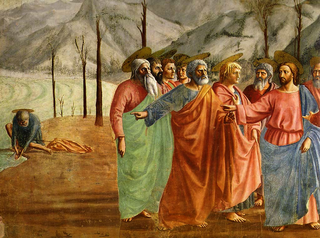

A halo (from Ancient Greek ἅλως, hálōs, 'threshing floor, disk'),[1][2] also called a nimbus, aureole, glory or gloriole (Latin: gloriola, lit. 'little glory'), is a crown of light rays, circle or disk of light[3] that surrounds a person in works of art. The halo occurs in the iconography of many religions to indicate holy or sacred figures, and has at various periods also been used in images of rulers and heroes. In the religious art of Ancient Greece, Ancient Rome, Christianity, Hinduism, and Buddhism (among other religions), sacred persons may be depicted with a halo in the form of a circular glow, or flames in Asian art, around the head or around the whole body—this last form is often called a mandorla.
Halos may be shown as almost any colour or combination of colours, but are most often depicted as golden, yellow or white (when representing light) or as red (when representing flames). The earliest artistic depictions of halos were probably in Ancient Egyptian art.[4]
- ^ Harper, Douglas. "halo". Online Etymology Dictionary.
- ^ ἅλως. Liddell, Henry George; Scott, Robert; A Greek–English Lexicon at the Perseus Project.
- ^ "halo – art". Encyclopedia Britannica.
- ^ Gamal, Shaza, and Noha Moustafa Shalaby. 2023. "The Concept of the Halo: A Dialogue Between Graeco-Roman and Byzantine Egypt." International Academic Journal Faculty of Tourism and Hotel Management 9 (1):1-30.